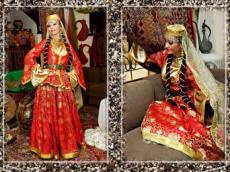|
|
TODAY.AZ / Arts & Entertainment
Russia to get familiarized with national Azerbaijani costumes
25 July 2014 [13:40] - TODAY.AZ
 By AzerNews
By AzerNewsNational costume of Azerbaijani women will be presented at a competition in Saransk, Mordovia.
The event will be held at the National Theatre of Mordovia on August 25, the Russian media reported.
The competition will also present national costume of Russian, Tatar, Mordovians, Ukrainians, Jews, and Cossacks women.
"We want people to know their roots, culture, history, and get familiar with the culture of other nationalities living near us. This strengthens friendly relations among people of different nations," one of the organizers of the event Alsu Myakusheva said.
The competition accepts both individual and collective works of designers of all age groups. The jury will include representative of each of the diasporas, which will make objective the process of evaluation.
The first three winners will be awarded with golden jewelry, and one more participant will receive a prize for the preservation and usage of the traditions of the national costume. An audience choice award will also be presented.
Azerbaijan national costume is the result of long processes involved in the development of the nation's material and intellectual culture, which reflects history and specific features of it.
Some twelve stages can be identified in the formation of Azerbaijani national costume. Each stage saw further development and improvement, corresponding to changing tastes and living conditions.
Back in centuries, women tend to choose the costume style appropriate to the family status and the age. The costume of a maiden differed noticeably from that of a married woman. Young women wore attractive garments.
The national costume was basically the same in all historical ethnographic zones of Azerbaijan.
Azerbaijan women's dress of the 19th century and the beginning of the 20th century consisted of lower and top dresses. The top wear consisted of top shoulder and belt wears. Women's top shoulder dress is top shirtdress, back dress and chapkan, a dress consisting of lining and false sleeves.
In the cities, women wore a veil over skirt when going outside.
National clothing set included a jewelry created by the local jewelers. Women wore the jewelry in neck, chest, waist, and wrist.
URL: http://www.today.az/news/entertainment/135696.html
 Print version
Print version
Views: 3720
Connect with us. Get latest news and updates.
See Also
- 28 November 2025 [18:34]
Azerbaijan represented at international symposium in Turkiye - 28 November 2025 [17:51]
Fuzuli's poetry comes to life through mugham art - 27 November 2025 [15:56]
Azerbaijan represented at int'l symposium dedicated to Silk Road - 27 November 2025 [14:20]
Tarana Muradova celebrates anniversary with fascinating dance evening - 27 November 2025 [12:19]
Young soloist takes stage in 'Asli and Kerem' opera - 26 November 2025 [18:31]
OIC Cultural Festival: Baku Creative Week 25 to feature MyForum panel sessions - 26 November 2025 [15:34]
Renowned pianist and young talent deliver heartwarming performance - 26 November 2025 [15:13]
Azerbaijani, Turkish Opera Theaters to undertake joint projects - 26 November 2025 [13:51]
Azerbaijan's cultural heritage promoted at Luxembourg Int'l Bazaar - 25 November 2025 [18:35]
Int'l Mugham Center to hold concert program themed 'Con Moto'
Most Popular
 Azerbaijan’s Deputy PM meets Russian counterpart to discuss bilateral cooperation
Azerbaijan’s Deputy PM meets Russian counterpart to discuss bilateral cooperation
 SOCAR to implement fully digital waste monitoring system across all operations
SOCAR to implement fully digital waste monitoring system across all operations
 Azerbaijan, Russia sign digital freight data exchange agreement
Azerbaijan, Russia sign digital freight data exchange agreement
 Pashinyan left Modi in broken trough
Pashinyan left Modi in broken trough
 Azerbaijani, Turkish Opera Theaters to undertake joint projects
Azerbaijani, Turkish Opera Theaters to undertake joint projects
 OIC Cultural Festival: Baku Creative Week 25 to feature MyForum panel sessions
OIC Cultural Festival: Baku Creative Week 25 to feature MyForum panel sessions
 Pashinyan vs Etchmiadzin: Armenian PM wins the next round
Pashinyan vs Etchmiadzin: Armenian PM wins the next round
